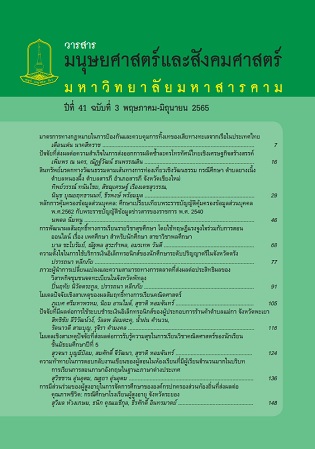ความท้าทายในการตอบกลับงานเขียนของผู้สอนในห้องเรียนที่มีผู้เรียนจำนวนมากในบริบทการเรียนการสอนภาษาอังกฤษในฐานะภาษาต่างประเทศ
Main Article Content
บทคัดย่อ
บทคัดย่อ
วัตถุประสงค์ของงานวิจัยครั้งนี้คือ 1) ศึกษาความท้าทายเชิงทฤษฏีในการตอบกลับงานเขียนของผู้สอนในห้องเรียนที่มีผู้เรียนจำนวนมากในบริบทการเรียนการสอนภาษาอังกฤษในฐานะภาษาต่างประเทศและ 2) ศึกษาความท้าทายเชิงปฏิบัติในการตอบกลับงานเขียนของผู้สอนในห้องเรียนที่มีผู้เรียนจำนวนมากในบริบทการเรียนการสอนภาษาอังกฤษในฐานะภาษาต่างประเทศ ผู้ร่วมวิจัยแบ่งออกเป็น 3 กลุ่ม ประกอบด้วย กลุ่มผู้สอนในห้องเรียนที่มีผู้เรียนจำนวนมากในบริบทการเรียนการสอนภาษาอังกฤษในฐานะภาษาต่างประเทศ 30 คน กลุ่มผู้สอนในการสัมภาษณ์ 3 คน และ กลุ่มผู้สอนในการสังเกตการณ์ 1 คน ข้อมูลถูกเปรียบเทียบจากมุมมอง 3 มุมมอง (Triangulation) โดยใช้แบบสอบถามความท้าทายในการตอบกลับงานเขียนของผู้สอนในห้องเรียนที่มีผู้เรียนจำนวนมากในบริบทการเรียนการสอนภาษาอังกฤษในฐานะภาษาต่างประเทศ แบบสัมภาษณ์แบบมีโครงสร้าง และ แบบสังเกตุการณ์ วิเคราะห์ข้อมูลเชิงปริมาณจากแบบสอบถามโดยใช้ ร้อยละ ค่าเฉลี่ย และ ส่วนเบี่ยงเบนมาตรฐาน วิเคราะห์ข้อมูลเชิงคุณภาพจากแบบสัมภาษณ์โดยใช้การวิเคราะห์แบบกำหนดกรอบประเด็น (Thematic Analysis) และ วิเคราะห์ข้อมูลจากการสังเกตโดยใช้การวิเคราะห์แบบพรรรณาวิเคราะห์ ผลการวิจัยชี้ให้เห็นศึกษาความท้าทายทั้งเชิงทฤษฏีและปฏิบัติในการตอบกลับงานเขียนของผู้สอนในห้องเรียนที่มีผู้เรียนจำนวนมากในบริบทการเรียนการสอนภาษาอังกฤษในฐานะภาษาต่างประเทศ ผลของงานวิจัยสามารถนำไปปรับใช้ในด้านการบริหารการศึกษา การพัฒนาการตอบกลับงานเขียน และ การศึกษาการเขียนในภาษาที่สอง
คำสำคัญ การตอบกลับงานเขียน ความท้าทาย การจัดการการสอน
Article Details
เอกสารอ้างอิง
Alkhatib, N. (2015). Written corrective feedback at a Saudi university: English language teachers’ beliefs, students’ preferences, and teachers’ practices. Essex, UK: University of Essex.
Benhow, J., Mizrachi, A., Oliver, D., & Said-Moshiro, L. (2007). Large class sizes in the developing world: What do we know and what can we do? Washington, DC, US: U.S. Agency for International Development.
Biggs, J., & Tang, C. (2011). Teaching for quality learning at university. New York: McGraw-Hill Education.
Bitchener, J., & Ferris, D. (2012). Written corrective feedback in second language acquisition and writing. New York: Routledge.
Bitchener, J, & Knoch, U. (2010). Raising the linguistic accuracy level of advanced L2 writers with written corrective feedback. Journal of Second Language Writing, 19, 207–217.
Ellis, R. (2009). A typology of written corrective feedback types. ELT Journal, 63(2), 97–107.
Ferris, D. (2006). Does error feedback help student writers? New evidence on the short—And long-term effects of written error correction. In K. Hyland & F. Hyland, Feedback in second language writing: Contexts and issues (pp. 81–104). Cambridge: Cambridge University Press.
Ferris, D., Lui, H., & Rabie, B. (2011). The job of teaching writing: Teacher views of responding to student writing. Writing and Pedagogy, 3, 14–37.
Hyland, F., & Hyland, K. (2001). Sugaring the pill: Praise and criticism in written feedback. Journal of Second Language Writing, 10(3), 185–212. https://doi.org/10.1016/S1060-3743(01)00038-8
Hyland, K. (2003). Writing and teaching writing in Second language writing. Cambridge: Cambridge University Press.
Küçükler, H., & Kodal, A. (2019). Foreign language teaching in over-crowded classes. English Language Teaching, 12(1), 169–175.
Lee, I. (n.d.). How do Hong Kong English teachers correct errors in student writing? Education Journal, 31(1), 153–169.
Lyster, R., & Ranta, L. (1997). Corrective feedback and learner uptake. Studies Second Language Acquisition, 19(1), 37–66.
Mao, S. S., & Crosthwaite, P. (2019). Investigating written corrective feedback: (Mis)alignment of teachers’ beliefs and practice. Journal of Second Language Writing, 45, 46–60. https://doi.org/10.1016/j.jslw.2019.05.004
Purnomo, W. W., Basthomi, Y., & Prayogo, J. A. (2021). EFL university teachers’ perspectives in written corrective feedback and their actual applications. International Journal of Evaluation and Research in Education (IJERE), 10(3), 1095–1105. https://doi.org/10.11591/ijere.v10i3.21641
Seloni, L., & Lee, S. (2019). Second language writing instruction in global contexts: English language teacher preparation and development. Bristol, UK: Multilingual Matters.
Shoja, M. & Narjes, G. (2017). The effect of explicit and implicit corrective feedback on the use of collocations in speaking assignments by Iranian EFL learners. International Journal of Research Studies in Language Learning, 6(1), 79–94.
Silva, T, & Matsuda, P. (2002). Writing. In N. Schmitt, An introduction to applied linguistics (pp. 251–266). Oxford, England: Oxford University Press.
Swain, M. (1995). Three functions of output in second language learning. In G. Cook, & B. Seidlhofer, Principle and practice in applied linguistics: Studies in honour of H. G. Widdowson (pp. 125–144). Oxford: Oxford University Press.
Wei, W., & Coa, Y. (2020). Written corrective feedback strategies employed by university English lecturers: A teacher cognition perspective. SAGE Open, 10(3), 1–12.
Zhang, T., Chen, X., Hu, J., & Ketwan, P. (2021). EFL students’ preferences for written corrective feedback: Do error types, language proficiency, and foreign language enjoyment matter? Frontiers in Psychology, 12, 660–564. https://doi.org/10.3389/fpsyg.2021.660564


